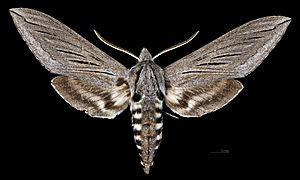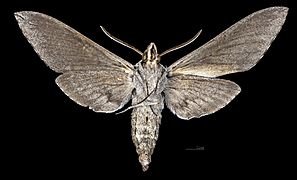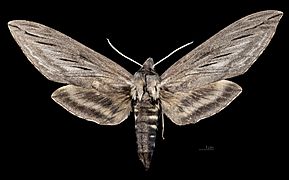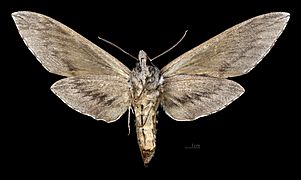Great ash sphinx facts for kids
Quick facts for kids Great ash sphinx |
|
|---|---|
 |
|
| Scientific classification | |
| Synonyms | |
|
The Great Ash Sphinx (scientific name: Sphinx chersis) is a large and interesting moth. It belongs to a group of moths called Sphingidae, also known as hawk moths or sphinx moths. These moths are known for their strong, fast flight and often look a bit like hummingbirds when they feed.
What They Look Like
This moth is quite big! Its wings can spread from about 90 to 130 millimeters wide. That's roughly the length of a smartphone.
The top side of its front wings is usually a soft dark gray or blue-gray. You'll see several black lines or dashes on them. One of these lines even reaches the very tip of the wing. The top side of its back wings is black with blurry, light gray bands.
The young moths, called larvae or caterpillars, are usually light green. They have blue dashes along their sides and a bluish-green horn at their rear. Sometimes, you might even spot a red version of the caterpillar!
Life Cycle and Habits
The caterpillars of the Great Ash Sphinx moth love to eat plants from the olive family (Oleaceae). This includes common plants like lilacs (Syringa species), ash trees (Fraxinus species), and privet (Ligustrum vulgare).
Once a caterpillar has eaten enough and grown big, it's time for the next stage. It burrows into the ground and forms a pupa. This is like a resting stage where it transforms into an adult moth. The pupa stays hidden underground, often dormant, until the next year.
Adult moths emerge from their pupae at different times depending on where they live. In warmer southern areas, they can appear from May to August. Farther north, you'll usually see them from June to July.
Adult moths are active at dusk, which is around sunset. They feed on nectar from flowers that have deep, tube-like shapes. Some of their favorite flowers include honeysuckles (Lonicera species), evening primroses, dogbane (Apocynum species), phlox (Phlox species), and bouncing bet (Saponaria officinalis).
Where They Live
You can find the Great Ash Sphinx moth in northern Mexico and across most of the United States. They tend to live wherever their favorite food plants for caterpillars are found. However, they are not very common in the states along the Gulf of Mexico.
Types of Great Ash Sphinx Moths
There are a couple of recognized types, or subspecies, of the Great Ash Sphinx:
- Sphinx chersis chersis: This type is found from Mexico all the way north through most of the United States.
- Sphinx chersis mexicanus: This type was identified by Rothschild & Jordan in 1903 and is found in Mexico.





